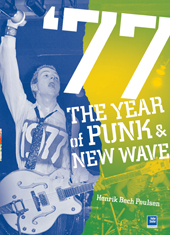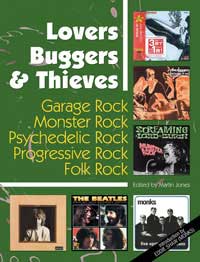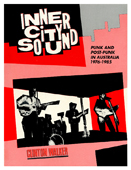
As much as I love records, my love for books isn't very far behind. I especially love it when those two worlds intersect. There are dozens of good 'rock books' out there, and I've taken a chance on most of them. And while the bio and autobio and oral history style books have some incredible tomes in their ranks, some I've read two, three, even six times over, I find the greatest pleasure and take the most delight in the discography. Any record hound worth their salt has a dog-eared copy or two of their favorite reference work close at hand to their turntable. Most start out with something fairly pedestrian, maybe an AMG Guide or some bullshit-packed Rolling Stone work in their wee years. Shit, I remember trying to look up bands in the encyclopedia as a young lad, trying to ascertain which Who records my Dad was missing from his (meaning our) collection. At some point, those inclined to be obsessive about record collecting and listening eventually come across a volume of the Trouser Press Record Guide, and cross a threshold of sorts into the upper levels of underground discographism. Obscure to a certain point (and certainly with some crap opinions), as simply a reference work the Trouser Press guides do their job effectively enough for the burgeoning fiend. Then, after some time with Ira Robbins and his cohorts, you realize there is still a whole lot more out there. And you graduate to the "Bible", that being B. George and Martha DeFoe's International Discography of the New Wave. Hardly opinionated and packed with more cold hard record facts, the Bible was perhaps the ultimate printed record reference work for those deep into what would come to be the Killed by Death era of 1978-1983 punk and its surrounding years/bands/scenes. Ripe with information on all the records you would never find, it was enough to keep you busy for years. Until you dug even deeper, into say the Flex Discography. And then, if you have the itch bad, you even started seeking out obscure foreign discographies that aren't even written in English. These books (along with frantic fanzine reading) were your only tools in the pre-internet days of information gathering. I still check them often, even though their usefullness now is fairly limited compared to great on-line reference works such as Justin Frohwith's Collector Scum , Evert Njikamp's Grunnen Rocks, Mark Murrmann's Lipstick Killers, Paul Routenberg's Killed By Hype, Kill from the Heart, and others. But the books still hold a special place for me, reminding me of a time when record collecting was still hard work (and it still can be) and tenacity and resourcefullness were more important tools than a Paypal account and an eBay log-in. And don't get me wrong, hard work still pays off far better dividends and prices in the long run these days, but those early years of being armed with a book and a pocketful of allowance money will always be a bit more special compared to these days of a mouse click and debit card.

So why the long-winded intro? Well, as much as I just like talking about my particular 'good old days', I felt I needed to establish the need and utility of record reference books. This shit needs to be cataloged and listed before the details are lost to time. And also because TB has received its first ever review copy of a printed work. And it happens to be a discography. And a good one at that. '77: The Year of Punk and New Wave, from Danish-born author Henrik Bech Poulson, takes a very particular angle on the discography. That being, it compiles only records released in 1977, the year that Poulsen claims was the best year for music ever, and also the year punk rock died. Further limiting the scope is the fact that only UK records and artists are included, giving us an ultra-detailed look at the 200 or so British (and Irish) bands that had a record (or a song on a comp) available in '77. At first it seems like that wouldn't make for such a good idea or such a long book. But when you actually have it in front of you, then you can appreciate the in-depth accounts and meticulous information that only such a limited scope would allow. The first twenty or so pages offer Poulson's reasoning for why 1977 was the greatest year ever for rock music, and I suppose he makes a respectable case for himself. I can't say I agree or disagree, as I think it's an argument that can't be decided, but 1977 certainly does loom large over rock history. And to get into the "When or where was Punk born or killed?" debate is moot. Me, I'm a firm believer that Punk was created in the US. But this book really isn't about that, or at least that is not what is enjoyable or useful about it. Poulson does present his preliminary historical information/argument in a style that reads much like a research paper or thesis on the subject, giving headings to thing like 'Gobbing', 'Punk Dress', "Pogo Dancing', and such, along with a timeline of events that led to the creation of what Punk was in '77 and the climate that it existed in. A lot of gloss for readers (or professors) who wouldn't normally be reading a book about Punk for the most part. Tidily presented, but fairly dry and holding no real revelations for anyone who should be really into the discography section. But those twenty pages (and a few pages given over to quotes/recollections from some famous and not-so famous punks who lived through it) are not the meat of this book at all, nor the reason why anyone should buy it. It's the 300 plus pages of 'Detailed Scope', as he calls it, the band-by-band entries, that make this thing worth the time.
Each particular entry is broken up into three parts. Firstly, a general bio, packed with ex-thisband and ex-thatband asides, elaborate info on the band's formation and history, items on their pre-1977 work if there was any, complete line-up info, their place in 1977 punk history, and other interesting tidbits. Obviously, someone like The Buzzcocks' or Clash get three to four pages, but even relative unknowns like Headache or Avant Gardener (just to name two) get at least a good half page of mention. The second part is their actual 1977 discography, which, for say, someone like Psychos is one line, but for Elvis Costello has at least a dozen entries. Did you know there were seven different sleeve color variations for the original Stiff issue of "My Aim Is True"? Or that the first self-released Neon Hearts 7" came in an oversize 8" sleeve to make it stick out in the record racks? Necessary collector knowledge like that is dropped frequently, and the detail in each entry is more than 'in-depth'. Scum stats like sleeve variants and alternate promo editions are discussed at length. Bands you would think might summon a few sentences of biography get three to four paragraphs. And the entries for obvious heavy-hitters, like the Pistols, manage to be concise and relevant and still contain a few obscure kernels. For bands that appeared on his show, there is also a listing for John Peel Sessions done in 1977. And thirdly, the Post-1977 section is just as detailed, and while eschewing discography information for anything later than the big year, Poulson does give us a fair account of what happened to the band and its members after '77, and also tends to acknowledge official reissues of any 1977 releases and appearances on Bloodstains and KBD comps. Personally, I can't think of any band that was not included, as even bands who made only the most minor comp appearance in '77 are given a fair shake (the GT's from the Raw Deal! comp for example). Everyone you can imagine is here, from pub rock vets like Slaughter and The Dogs and Kilburn and the High Roads, to young punks like Eater and Johnny Moped, to arcane acts like The Stoat and Lucy. Even B-list acts like Pork Dukes and Blitzkreig Bop get immaculate treatment. Also, each entry is packed with band pics, press releases, flyers/handbills, and usually the sleeve and label for each release. Plus, there's a 16-page color section, a collage of both obscure and well-known record covers and inner labels.
As far as discographies go, the research is well done and the information is presented in easily usable format. Given its restricted scope, one may think it's relevance would be somewhat limited, and in a way I suppose it is. But the painstaking detail makes up for any shortcomings on that end, and the sheer amount of legendary releases from that year (and just from the UK!) are awe-inspiring when taken as a whole. For the novice record buff, it may be a bit too much, yet the biographies should appeal to any fan at least as far as bathroom reading. But for anyone deeply into punk and its recorded legacy it is an invaluable addition to the library. As a reference it succeeds; the twenty or so pages of written history are nothing special, but are not the reason anyone should consider a purchase. Don't buy this looking for an "England's Dreaming" or "Please Kill Me" style history. If you are the type who loves records a bit too much and still pore over Flex, The Bible, and the like, well this is definitely for you. And whether or not Poulson does convince of you of his theory of 1977 being the best year ever for music, the over 200 band entries build a decent case. What Punk '77 really did for me was make me wish there was a volume for every year, for every country. A Punk History Encyclopedia, with Belgian, French, US, Swedish volumes and more, divided into years, covering all aspects of punk genealogically and geographically in similar detail. Perhaps this volume can spur some knowledgable parties in that direction...
'77: The Year of Punk and New Wave is available through Helter Skelter Books .
CAPSULES:
Lovers, Buggers and Thieves Vol.1, ed. Martin Jones ( Headpress/Critical Vison )
 If you're not at all familiar with Headpress, they are a UK based publishing imprint that specialize in all things underground. There's an actual Headpress "magazine" (which is actually a small book) that is issued bi-annually or so that contains articles on anything from unknown films and televison (with a slant towards UK/BBC stuff), porn, underground music, mind-altering substances, counter-culture icons, comics, pulp books/magazines, and just about anything else in the realm of obscure pop culture. They also do a great series of books/mags called 'Creeping Flesh', a collection of articles on Horror/Fantasy films (there are two excellent volumes so far), of which 'Lovers, Buggers, and Thieves' is the sort of music-related version of. So there should be more volumes where this came from. This first installment, sub-titled "Garage Rock, Monster Rock, Psychedelic Rock, Progressive Rock, Folk Rock", may be some of Headpress' best work yet. Included from various authors are: a detailed Sonics biography, 10+ pages of Monks stuff, in depth discussion of Manson's LIE album and his other musical (and non-musical) exploits, "Messiahs of Voltage: How The Stooges Died For You" which is nearly thirty pages of the best Stooges bio you will ever read and the greatest piece written on the band by anyone not named Lester Bangs, a fascinating article on Beatles boots and "outfakes" that will interest even a Beatle-hater like myself, a piece on obscure Mexican vinyl that might even teach old Soriano a few things, plus even more stuff on Bonzo Dog Band, Screaming Lord Sutch, the Sixties Australian Psych scene, Edgar Broughton, the Sixties Aussie Garage Scene, Skip Spence, 1970s UK Bootlegs, crazy Eighties metal band The Wild, and a Led Zeppelin vs. Iron Butterfly argument from none other than Crime's Johnny Strike. Plus, there are are short pieces on "Disturbo Music" breaking up the longer articles, a foreward by Monk Eddie Shaw, and an introduction by the impeccable Michael Lucas. Need I say anything more? Nearly 200 pages of very intelligent rock dope that is so good you will actually take it out of the bathroom. Extremely entertaining and well written and easily available on the cheap domestically. Also, check out the rest of the Headpress catalog for other goodies.
If you're not at all familiar with Headpress, they are a UK based publishing imprint that specialize in all things underground. There's an actual Headpress "magazine" (which is actually a small book) that is issued bi-annually or so that contains articles on anything from unknown films and televison (with a slant towards UK/BBC stuff), porn, underground music, mind-altering substances, counter-culture icons, comics, pulp books/magazines, and just about anything else in the realm of obscure pop culture. They also do a great series of books/mags called 'Creeping Flesh', a collection of articles on Horror/Fantasy films (there are two excellent volumes so far), of which 'Lovers, Buggers, and Thieves' is the sort of music-related version of. So there should be more volumes where this came from. This first installment, sub-titled "Garage Rock, Monster Rock, Psychedelic Rock, Progressive Rock, Folk Rock", may be some of Headpress' best work yet. Included from various authors are: a detailed Sonics biography, 10+ pages of Monks stuff, in depth discussion of Manson's LIE album and his other musical (and non-musical) exploits, "Messiahs of Voltage: How The Stooges Died For You" which is nearly thirty pages of the best Stooges bio you will ever read and the greatest piece written on the band by anyone not named Lester Bangs, a fascinating article on Beatles boots and "outfakes" that will interest even a Beatle-hater like myself, a piece on obscure Mexican vinyl that might even teach old Soriano a few things, plus even more stuff on Bonzo Dog Band, Screaming Lord Sutch, the Sixties Australian Psych scene, Edgar Broughton, the Sixties Aussie Garage Scene, Skip Spence, 1970s UK Bootlegs, crazy Eighties metal band The Wild, and a Led Zeppelin vs. Iron Butterfly argument from none other than Crime's Johnny Strike. Plus, there are are short pieces on "Disturbo Music" breaking up the longer articles, a foreward by Monk Eddie Shaw, and an introduction by the impeccable Michael Lucas. Need I say anything more? Nearly 200 pages of very intelligent rock dope that is so good you will actually take it out of the bathroom. Extremely entertaining and well written and easily available on the cheap domestically. Also, check out the rest of the Headpress catalog for other goodies.
Inner City Sound: Punk and Post-Punk in Australia 1976-1985, by Clinton Walker ( Verse Chorus Press )
 Have you ever looked for a book or record for so long, and come close many times to having it in your hands and failing, that frustration and time eventually lead you to forget about it? And then one day you walk into some unsuspecting out-of-town record store years later and there it is? This happened to me with 'Inner City Sound'. I was hot on the trail of this years ago during a period of overwhelming obsession with Aussie punk. It was nearly impossible to find, as it was first issued in 1982 in Australia and never reprinted. Copies were going for hefty sums (for me at the time, at least) on eBay. Eventually I gave up or moved on as my obsessions ran me into other country's music scenes and other rarities to chase. So I was pleasantly shocked to see it blatantly displayed on the book shelf at My Mind's Eye in Cleveland when I was visiting for Horriblefest. It was one of those gut-churning moments when even though no one else is really in the store or even within grabbing distance of the rare item you desire, you try to act cool and snatch it as quickly as possible without looking like a total scum, all the while ready to pummel anyone else who might look like they may even want to glance at it before before you get your mitts on it. So I see it's remarkably priced at $25, and I get even happier. Turns out it's a repress (which is 100% fine with me), done in 2005 by Verse Chorus, who also happen to be the publishers of the now defunct Puncture magazine. Apparently it was made available again not so much due to Walker's displeasure with its unavailability and collectibility, but mainly because of the fact he saw all the US and UK punk/post-punk bands getting all the press (yet again) and was pissed at the incredible Australian scene getting the short shrift as usual. A noble motivation for sure. And Inner City Sound is a remarkable book, in that it is not a retrospective look at the Aussie scene written years later, but a compilation of articles from fanzines and newspapers that were written while things were actually happening. Made up up six chapters, one for each year from '76/'77 through '81 (which was the original scope of the book), the expansion to 1985 in the title applies to additional material added in the final chapter covering 1982-85 and the accompanying discography in the new edition. The fact that this is stuff written as it was was occurring lends it a certain fanzine-perspective charm (and dates the material a bit), and the excitement surrounding (and trepidations about) what was happening is conveyed well by Walker and the other original authors. Hundreds of photos, flyers, posters, and actual reprints directly from the original zines make for some great looking pages as well. The articles and interviews are of course fairly skewed towards big names like Birdman, Saints, X, Boys Next Door/Birthday Party, Go-Betweens, and Scientists, but the majority is stuff that hasn't been seen elsewhere. More obscure acts like the Young Identities, Rocks, Primitive Calculators and others barely get a mention aside from the discography (most likely due to geographic solitude in some cases), but the Psychosurgeons and Thought Criminals and others do get a fair amount of coverage. Also, bands who may not seem to have mattered so much in the long run (Sunnyboys, Laughing Clowns, that band whose name was a bunch of arrows, etc) get a bit more coverage than you would expect. Walker also does do a good job of excluding (and making fun of) punk cash-ins like INXS, Midnight Oil, and Icehouse. Combined with the semi-recent 'Alternative Animals' CD-ROM, you would probably have the ultimate Aussie punk reference. Despite some very minor shortcomings, Inner City Sound is still the best book on Aussie punk you're going to find.
Have you ever looked for a book or record for so long, and come close many times to having it in your hands and failing, that frustration and time eventually lead you to forget about it? And then one day you walk into some unsuspecting out-of-town record store years later and there it is? This happened to me with 'Inner City Sound'. I was hot on the trail of this years ago during a period of overwhelming obsession with Aussie punk. It was nearly impossible to find, as it was first issued in 1982 in Australia and never reprinted. Copies were going for hefty sums (for me at the time, at least) on eBay. Eventually I gave up or moved on as my obsessions ran me into other country's music scenes and other rarities to chase. So I was pleasantly shocked to see it blatantly displayed on the book shelf at My Mind's Eye in Cleveland when I was visiting for Horriblefest. It was one of those gut-churning moments when even though no one else is really in the store or even within grabbing distance of the rare item you desire, you try to act cool and snatch it as quickly as possible without looking like a total scum, all the while ready to pummel anyone else who might look like they may even want to glance at it before before you get your mitts on it. So I see it's remarkably priced at $25, and I get even happier. Turns out it's a repress (which is 100% fine with me), done in 2005 by Verse Chorus, who also happen to be the publishers of the now defunct Puncture magazine. Apparently it was made available again not so much due to Walker's displeasure with its unavailability and collectibility, but mainly because of the fact he saw all the US and UK punk/post-punk bands getting all the press (yet again) and was pissed at the incredible Australian scene getting the short shrift as usual. A noble motivation for sure. And Inner City Sound is a remarkable book, in that it is not a retrospective look at the Aussie scene written years later, but a compilation of articles from fanzines and newspapers that were written while things were actually happening. Made up up six chapters, one for each year from '76/'77 through '81 (which was the original scope of the book), the expansion to 1985 in the title applies to additional material added in the final chapter covering 1982-85 and the accompanying discography in the new edition. The fact that this is stuff written as it was was occurring lends it a certain fanzine-perspective charm (and dates the material a bit), and the excitement surrounding (and trepidations about) what was happening is conveyed well by Walker and the other original authors. Hundreds of photos, flyers, posters, and actual reprints directly from the original zines make for some great looking pages as well. The articles and interviews are of course fairly skewed towards big names like Birdman, Saints, X, Boys Next Door/Birthday Party, Go-Betweens, and Scientists, but the majority is stuff that hasn't been seen elsewhere. More obscure acts like the Young Identities, Rocks, Primitive Calculators and others barely get a mention aside from the discography (most likely due to geographic solitude in some cases), but the Psychosurgeons and Thought Criminals and others do get a fair amount of coverage. Also, bands who may not seem to have mattered so much in the long run (Sunnyboys, Laughing Clowns, that band whose name was a bunch of arrows, etc) get a bit more coverage than you would expect. Walker also does do a good job of excluding (and making fun of) punk cash-ins like INXS, Midnight Oil, and Icehouse. Combined with the semi-recent 'Alternative Animals' CD-ROM, you would probably have the ultimate Aussie punk reference. Despite some very minor shortcomings, Inner City Sound is still the best book on Aussie punk you're going to find.
-Rich Kroneiss
Please feel free to send Terminal Boredom your (music-related) books, fanzines, digests, or whatever for review, we'd be more than happy to give them coverage in future "Let us Read..." installments.
PREVIOUS PAGE HOME NEXT PAGE
|

